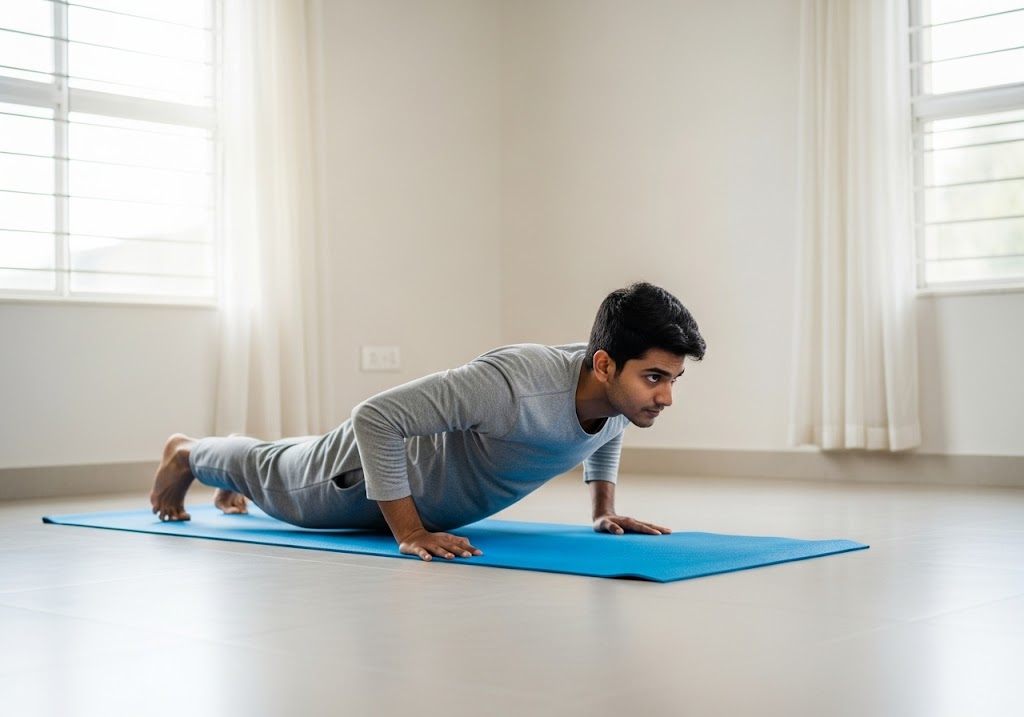What Is Foam Rolling? Foam rolling is a self-massage technique that uses a cylindrical foam tool to apply pressure to muscles and connective tissues. 8 Essential Benefits of Understanding What is Foam Rolling are muscle recovery, improved flexibility, reduced soreness, better circulation, injury prevention, enhanced performance, stress relief, and cost-effective therapy.
Understanding what is foam rolling helps you discover this self-massage technique that uses cylindrical tools to apply pressure to muscles, fascia, and trigger points for recovery and performance enhancement. Learning what is foam rolling empowers you to take control of your muscle health and recovery through simple, effective techniques.
Table of Contents
What Is Foam Rolling?
Foam rolling is a self-massage technique that uses a cylindrical foam tool to apply pressure to muscles and connective tissues. This practice, also known as self-myofascial release, helps break up muscle knots, improve blood flow, and enhance flexibility through targeted pressure application on tight or sore areas.
Understanding warm up exercises for beginners complements foam rolling techniques for comprehensive muscle preparation and recovery.
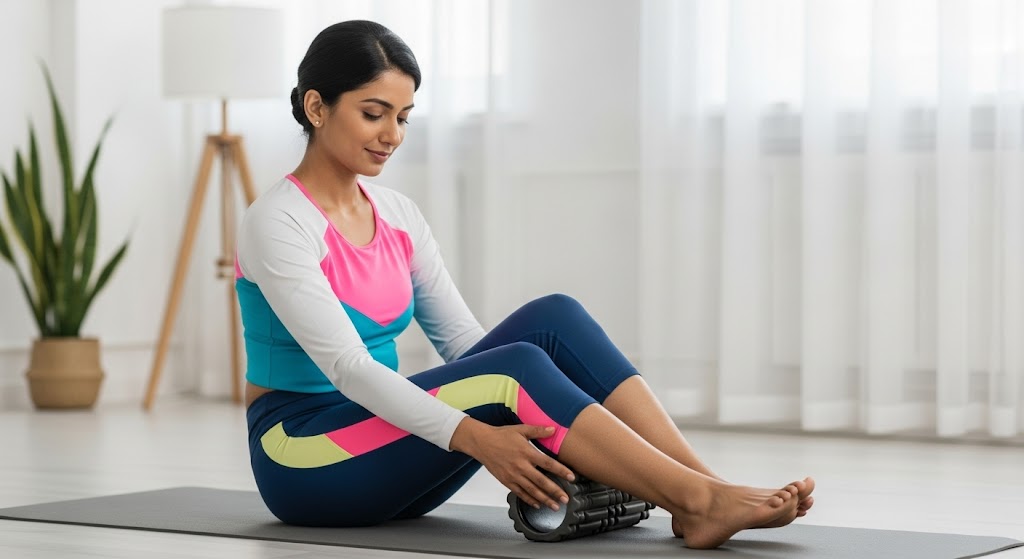
What Does Foam Rolling Do?
Understanding what does foam rolling do reveals how this technique affects your muscles, fascia, and overall recovery process. Foam rolling creates pressure that helps release muscle tension, improve tissue quality, and enhance blood circulation throughout targeted areas.
When you apply pressure with a foam roller, it helps break up adhesions in muscle fibers and fascia, the connective tissue surrounding muscles. This process, known as myofascial release, reduces muscle stiffness and improves range of motion.
What is foam rolling’s mechanism involves applying controlled pressure to trigger points, which stimulates blood flow and helps flush out metabolic waste products while delivering fresh nutrients to muscles.
Foam Rolling Exercises
Learning specific foam rolling exercises helps you target different muscle groups effectively while understanding what is foam rolling exercise techniques. These fundamental movements provide the foundation for comprehensive self-massage and muscle recovery routines.
| Exercise | Target Area | Duration | Pressure Level |
| IT Band Roll | Outer thigh | 30-60 seconds | Medium |
| Calf Roll | Lower leg | 30-60 seconds | Light to Medium |
| Quad Roll | Front thigh | 30-60 seconds | Medium |
| Hamstring Roll | Back thigh | 30-60 seconds | Medium |
| Back Roll | Upper/Lower back | 30-60 seconds | Light |
| Glute Roll | Buttocks | 30-60 seconds | Medium |
| Shoulder Roll | Upper back/shoulders | 30-60 seconds | Light |
| Lat Roll | Side torso | 30-60 seconds | Medium |
- IT Band Rolling: Lie on your side with the foam roller under your outer thigh. Support your weight with your forearms and opposite leg, then roll slowly from hip to knee. This exercise targets the iliotibial band, helping reduce lateral knee pain and hip tightness.
- Calf Rolling: Sit with legs extended and place the foam roller under your calves. Use your hands to lift your hips slightly and roll from ankle to knee. This movement helps reduce calf tightness and improves ankle mobility.
- Quadriceps Rolling: Lie face down with the foam roller under your front thighs. Support your weight on your forearms and roll from hip to knee, avoiding rolling directly over the kneecap. This exercise helps reduce anterior thigh tension.
- Hamstring Rolling: Sit with legs extended and place the foam roller under the back of your thighs. Use your hands for support and roll from below your glutes to above your knees. This exercise helps reduce posterior thigh tightness and improves hip flexibility.
- Back Rolling: Lie on your back with the foam roller positioned under your upper or lower back. Keep your knees bent and feet flat on the floor. Use your legs to move your body over the roller, avoiding the lower lumbar spine. This helps reduce back tension and improve spinal mobility.
- Glute Rolling: Sit on the foam roller with it positioned under your buttocks. Place one ankle over the opposite knee and lean toward the lifted leg side. Roll slowly to target different areas of the glute muscles, helping reduce hip tightness and improve mobility.
- Shoulder Rolling: Lie on your side with the foam roller positioned under your shoulder and upper back area. Use your opposite hand for stability and roll slowly to target the upper trapezius and shoulder blade region, helping reduce upper body tension.
- Lat Rolling: Lie on your side with the foam roller under your armpit and side torso. Extend your arm overhead and roll from your armpit toward your lower ribs. This exercise targets the latissimus dorsi muscle, improving shoulder mobility and reducing side torso tightness.
Building core stability through how to do plank exercise techniques supports proper foam rolling positions and body control.
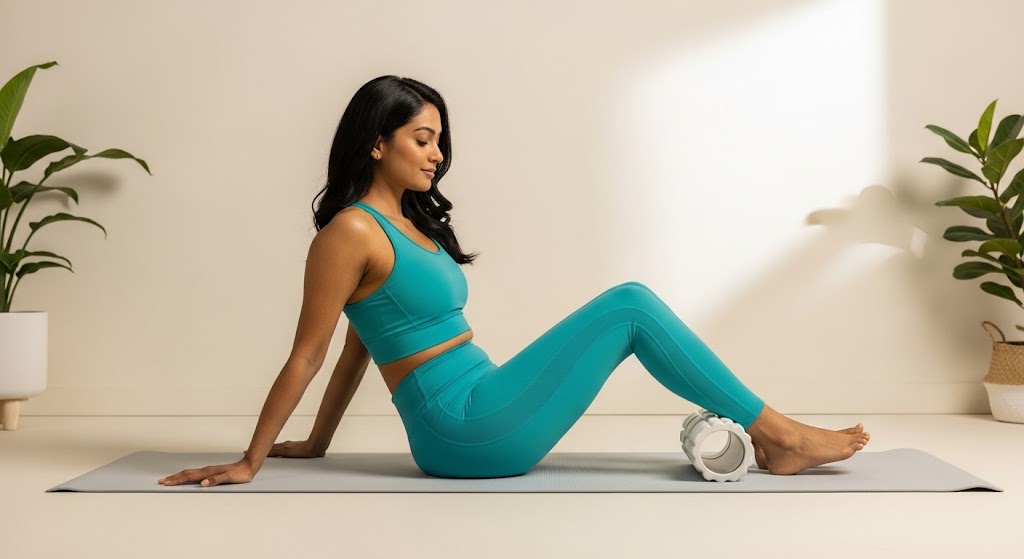
Benefits of Foam Rolling
Understanding the benefits of foam rolling motivates consistent practice while revealing why this self-massage technique is essential for muscle health and athletic performance. These advantages extend beyond simple muscle relaxation to include functional improvements and injury prevention.
- Enhanced Muscle Recovery: Regular foam rolling accelerates muscle recovery by improving blood circulation and reducing metabolic waste accumulation that contributes to post-exercise soreness and stiffness.
- Improved Flexibility and Range of Motion: Foam rolling helps lengthen tight muscles and fascia, leading to increased flexibility and joint range of motion without the time commitment of extensive stretching routines.
- Reduced Muscle Soreness: The pressure applied during foam rolling helps break up muscle knots and trigger points, reducing delayed onset muscle soreness (DOMS) and everyday muscle tension.
- Injury Prevention: By maintaining healthy muscle tissue and identifying tight spots before they become problematic, foam rolling serves as a proactive injury prevention strategy for active individuals.
- Enhanced Athletic Performance: Improved muscle quality, flexibility, and recovery from foam rolling can lead to better athletic performance through optimized movement patterns and reduced compensations.
- Cost-Effective Therapy: Foam rolling provides many benefits of professional massage therapy at a fraction of the cost, making regular muscle maintenance accessible and convenient.
- Stress Relief and Relaxation: The rhythmic pressure and focused attention required for foam rolling can provide mental relaxation and stress relief similar to meditation or mindfulness practices.
- Better Sleep Quality: Reduced muscle tension and relaxation from evening foam rolling sessions can contribute to improved sleep quality and more restful recovery periods.
For comprehensive recovery, explore calisthenics core workout routines that complement foam rolling practices.

Should You Use a Foam Roller?
Determining whether you should use a foam roller depends on your activity level, muscle tightness, and recovery needs. Most people benefit from foam rolling, especially those who exercise regularly or experience muscle stiffness.
You should consider foam rolling if you experience regular muscle soreness, have tight spots limiting movement, or want improved recovery between workouts. Athletes and fitness enthusiasts find foam rolling particularly beneficial for maintaining muscle health.
However, certain medical conditions may require caution before starting foam rolling. People with blood clots, severe osteoporosis, or acute injuries should consult healthcare providers before beginning practice.
Is Foam Rolling Safe?
Understanding foam rolling safety helps you practice this technique effectively while minimizing risks and maximizing benefits. When performed correctly with appropriate pressure and technique, foam rolling is generally safe for most healthy individuals.
The safety depends largely on proper technique and avoiding excessive pressure. Using too much force can cause bruising or tissue damage. Avoid rolling directly over joints, bones, or acute injuries.
What is foam rolling’s safety profile also depends on individual factors like medical history and current health status. People with diabetes, cardiovascular disease, or bleeding disorders should consult healthcare providers first.
Many people wonder does calisthenics build muscle effectively? Combining foam rolling with bodyweight training enhances both muscle development and recovery.
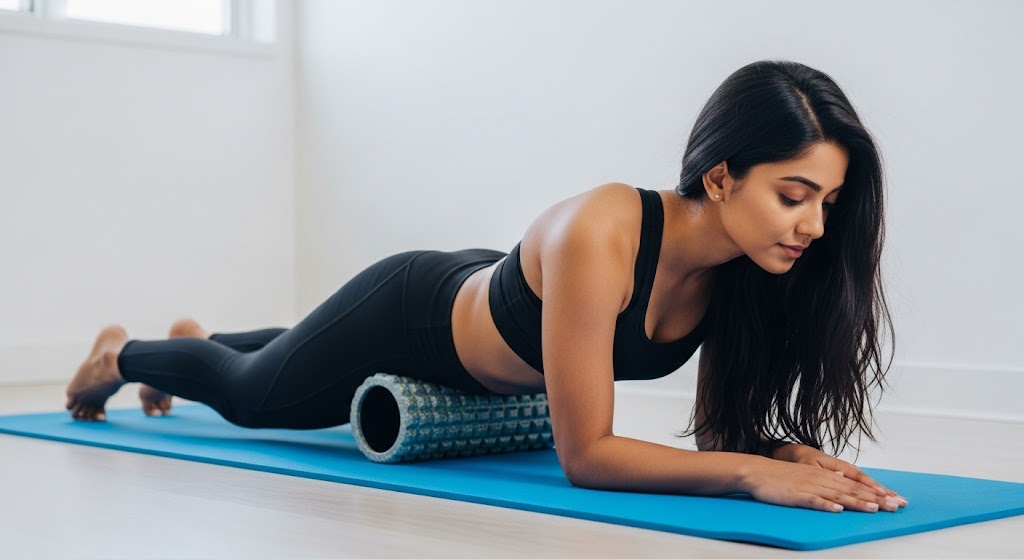
How to Choose a Foam Roller?
Selecting the right foam roller is crucial for effective practice and long-term success with this recovery technique. Understanding what is foam rolling equipment options helps you make informed decisions based on your needs, experience level, and specific goals.
| Roller Type | Density | Best For | Price Range |
| Basic Foam | Soft | Beginners, sensitive areas | $10-25 |
| EVA Foam | Medium | General use, most people | $15-35 |
| Hollow Plastic | Firm | Advanced users, deep pressure | $20-50 |
| Textured | Variable | Specific trigger points | $25-60 |
| Vibrating | Variable | Enhanced muscle activation | $100-300 |
| Travel Size | Variable | Portability, convenience | $15-40 |
- Density Considerations: Choose roller density based on your experience level and pain tolerance. Softer rollers work well for beginners and sensitive areas, while firmer rollers provide deeper pressure for experienced users and stubborn knots.
- Size Selection: Standard 36-inch rollers work well for full-body use, while shorter 18-inch rollers offer better portability and targeted work. Consider your available space and travel needs when selecting roller length.
- Surface Texture: Smooth rollers provide even pressure distribution, while textured rollers with bumps or ridges can target specific trigger points more effectively. Start with smooth surfaces before progressing to textured options.
- Special Features: Vibrating rollers add another dimension to muscle stimulation, while hollow rollers are lighter and often firmer. Consider these features based on your specific needs and budget constraints.
Understanding how to start calisthenics provides foundation knowledge for incorporating foam rolling into comprehensive fitness routines.
How To Use a Foam Roller?
Learning proper foam rolling technique ensures maximum benefits while minimizing discomfort and injury risk. Understanding what is foam rolling technique helps you perform this self-massage effectively and safely.
- Basic Technique Principles: Position the foam roller under the target muscle group and use your body weight to apply pressure. Roll slowly, spending 30-60 seconds on each area. When you find a particularly tight or sore spot, pause and maintain pressure for 15-30 seconds.
- Pressure Control: Start with light pressure and gradually increase as tolerated. You should feel pressure and mild discomfort, but not severe pain. Use your hands and non-rolling leg to control how much body weight you apply to the roller.
- Rolling Speed: Move slowly across the muscle, approximately one inch per second. Quick rolling reduces effectiveness and may cause muscle guarding or increased tension. Maintain steady, controlled movements throughout each session.
- Breathing Technique: Breathe deeply and regularly throughout your foam rolling session. Holding your breath can increase muscle tension and reduce the effectiveness of the technique. Use breathing to help you relax into the pressure.
- Session Structure: Begin with larger muscle groups before moving to smaller areas. Roll each target area for 30-60 seconds, then move to the next muscle group. Complete sessions typically last 10-20 minutes depending on areas covered.
For targeted muscle work, explore calisthenics leg exercises that complement foam rolling for comprehensive lower body care.
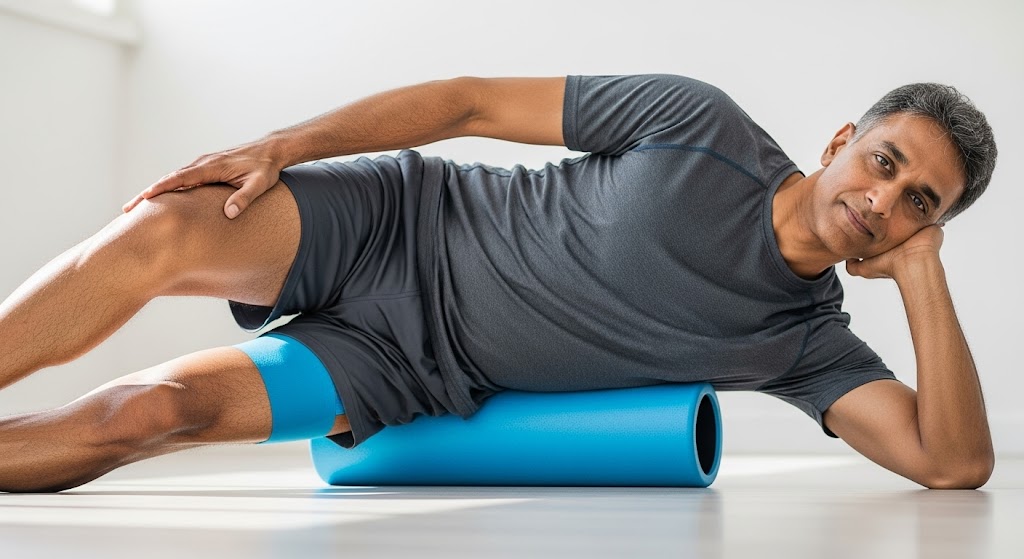
When to Use a Foam Roll – Before or After a Workout?
Understanding optimal timing for foam rolling maximizes its benefits for performance and recovery. What is foam rolling’s best timing depends on your goals, whether you’re preparing for activity or focusing on recovery and muscle maintenance.
Pre-Workout Foam Rolling
Using foam rolling before exercise can help prepare muscles for activity by increasing blood flow and improving range of motion. Focus on light pressure and shorter sessions (5-10 minutes) to avoid over-relaxing muscles before intense activity.
Pre-workout foam rolling should target areas that typically feel tight or restricted. Avoid aggressive pressure that might temporarily weaken muscles or reduce power output. Think of pre-exercise rolling as muscle activation rather than deep tissue work.
Post-Workout Foam Rolling
After exercise, foam rolling helps accelerate recovery by promoting blood flow and reducing muscle tension accumulated during training. Post-workout sessions can be longer (10-20 minutes) and include more pressure for deeper tissue work.
This timing allows for more thorough muscle work since you’re not immediately preparing for physical activity. Focus on areas that feel particularly tight or areas you worked heavily during your exercise session.
Daily Maintenance Rolling
Many people benefit from daily foam rolling sessions independent of workouts. These maintenance sessions help manage chronic tightness, improve overall muscle quality, and prevent the accumulation of tension from daily activities.
Evening foam rolling sessions can promote relaxation and better sleep quality, while morning sessions can help prepare your body for the day’s activities.
Building full-body strength through bodyweight exercises for beginners creates a foundation that benefits from regular foam rolling maintenance.
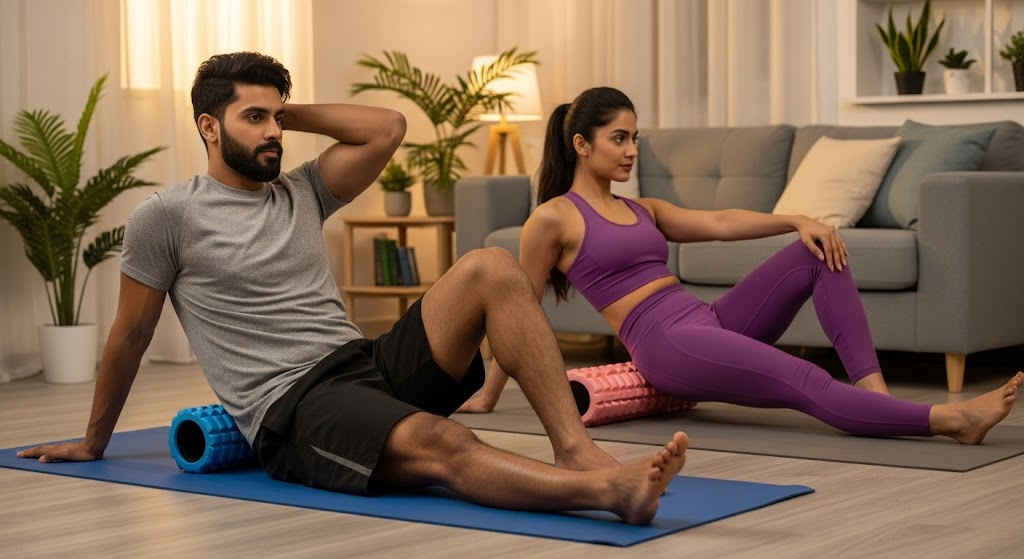
Common Foam-Rolling Mistakes to Avoid
Understanding common foam rolling mistakes helps you practice this technique effectively while avoiding counterproductive habits. What is foam rolling’s proper execution requires awareness of these frequent errors that can reduce effectiveness or cause discomfort.
- Rolling Too Fast: Moving quickly across muscles reduces the effectiveness of foam rolling and prevents proper tissue response. Always roll slowly, allowing time for muscle fibers to respond to pressure.
- Using Excessive Pressure: Applying too much force can cause muscle guarding, bruising, or increased soreness. Start with light pressure and gradually increase as your tolerance improves over time.
- Rolling Over Joints and Bones: Avoid rolling directly over joints, bony prominences, or areas without muscle tissue. This can cause discomfort and doesn’t provide therapeutic benefits.
- Holding Your Breath: Breath holding increases muscle tension and reduces the relaxation benefits of foam rolling. Maintain steady, deep breathing throughout your session.
- Ignoring Pain Signals: Severe pain during foam rolling indicates too much pressure or potential injury. Reduce pressure or avoid the area if you experience sharp or intense pain.
- Rolling Injured Areas: Avoid foam rolling over acute injuries, inflamed tissues, or areas with open wounds. Allow injuries to heal before resuming foam rolling in those areas.
- Inconsistent Practice: Sporadic foam rolling provides limited benefits compared to regular, consistent practice. Establish a routine that fits your schedule and stick to it.
- Neglecting Proper Positioning: Poor body positioning reduces effectiveness and may cause strain. Ensure proper alignment and support during all foam rolling movements.
How to Start Foam Rolling?
Beginning your foam rolling journey requires understanding basic techniques and gradually building tolerance and skill. What is foam rolling for beginners involves starting simply and progressing systematically to develop effective self-massage habits.
- Week 1-2: Foundation Building: Start with a basic foam roller and focus on major muscle groups like calves, hamstrings, and quadriceps. Use light pressure and roll for 30 seconds per area. Practice 3-4 times per week to develop familiarity with the technique.
- Week 3-4: Pressure Progression: Gradually increase pressure as your tolerance improves. Add new areas like glutes and IT bands to your routine. Extend rolling time to 45-60 seconds per muscle group while maintaining proper form.
- Week 5-8: Routine Expansion: Develop a comprehensive routine covering all major muscle groups. Learn to identify and target specific tight spots or trigger points. Consider adding pre and post-workout rolling sessions.
- Long-term Development: After two months, you’ll have developed good technique and tolerance. Consider upgrading to different roller types, exploring advanced techniques, or targeting specific problem areas based on your activities and needs.
- Safety First: Always start conservatively and listen to your body. If you experience unusual pain or discomfort, reduce pressure or consult a healthcare professional. Remember that some soreness is normal when beginning foam rolling.
For comprehensive recovery support, explore calisthenics for weight loss programs that benefit from regular foam rolling maintenance.
Advanced Foam Rolling Techniques
As you become comfortable with basic foam rolling, advanced techniques can enhance your results and target specific issues more effectively. Understanding what is foam rolling’s advanced applications helps you maximize this recovery tool’s potential.
- Pin and Stretch Technique: Place the foam roller on a tight spot and maintain pressure while moving the joint through its range of motion. This technique combines static pressure with dynamic movement for enhanced tissue release.
- Cross-Friction Rolling: Roll perpendicular to muscle fiber direction to address adhesions between muscle layers. This technique requires good anatomical knowledge and should be performed carefully with moderate pressure.
- Trigger Point Therapy: Identify specific tender points and apply sustained pressure for 30-90 seconds until the point releases. This advanced technique requires patience and good body awareness to be effective.
- Progressive Pressure: Start with light pressure and gradually increase during each session as muscles relax and adapt. This approach allows for deeper work while respecting tissue tolerance.
Advanced practitioners might explore complex movements like calisthenics planche that benefit from the improved mobility foam rolling provides.
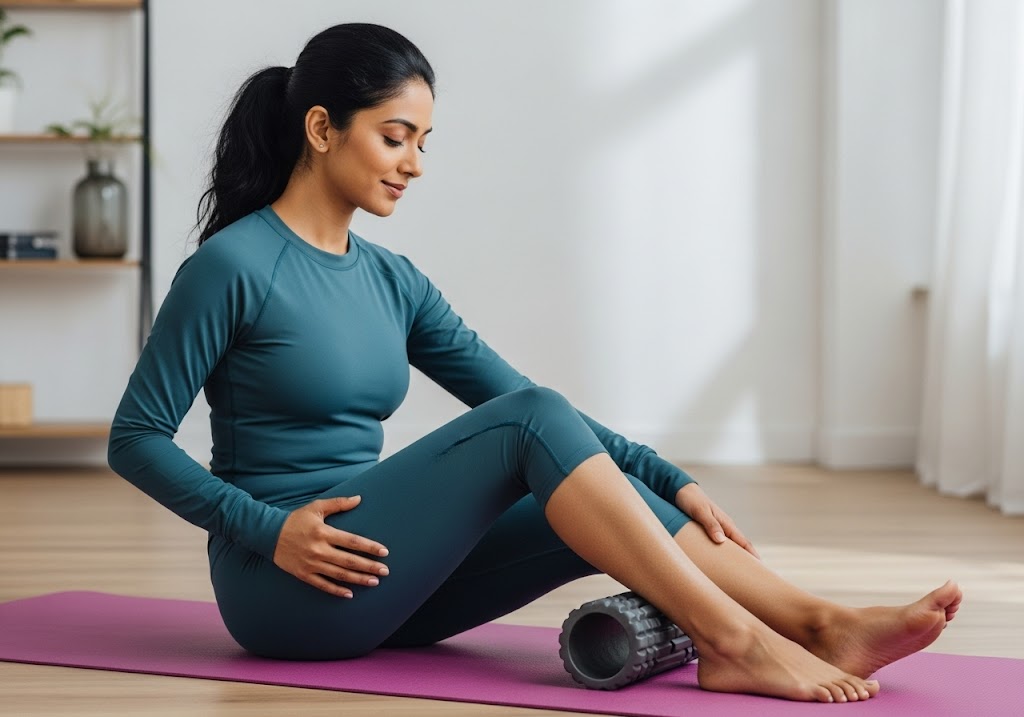
Integration with Other Recovery Methods
Understanding how foam rolling fits with other recovery techniques maximizes your overall muscle health and performance. What is foam rolling’s role in comprehensive recovery includes synergy with stretching, massage, and other self-care practices.
- Foam Rolling and Stretching: Combine foam rolling with static stretching for enhanced flexibility gains. Use foam rolling to prepare tissues before stretching or to maintain gains after stretching sessions.
- Heat and Cold Therapy: Alternate foam rolling with heat application to enhance blood flow or follow with ice for inflammation control. These combinations can be particularly effective for acute soreness or chronic issues.
- Professional Massage: Use foam rolling between professional massage sessions to maintain benefits and extend the time between appointments. Communicate with your massage therapist about your foam rolling routine.
- Active Recovery: Incorporate foam rolling into active recovery days along with light movement and gentle exercise. This combination supports recovery without complete rest.
For comprehensive core development that supports better foam rolling positions, explore calisthenics ab workout routines.
Measuring Progress and Results
Tracking your foam rolling progress helps maintain motivation and adjust techniques for optimal results. Understanding what is foam rolling’s measurable benefits guides your practice and helps identify areas for improvement.
- Flexibility Assessments: Regularly test range of motion in major joints to track mobility improvements from consistent foam rolling practice. Document changes in shoulder reach, hip flexibility, and ankle range of motion.
- Pain and Soreness Tracking: Monitor daily muscle soreness levels and recovery time between workouts. Many people notice reduced soreness and faster recovery within 2-4 weeks of regular foam rolling.
- Sleep Quality Monitoring: Track sleep quality and duration, as many people report improved sleep when incorporating evening foam rolling routines into their schedules.
- Performance Indicators: Notice improvements in exercise performance, movement quality, and overall comfort during daily activities. These functional improvements often reflect the benefits of consistent foam rolling practice.
Conclusion
Understanding what is foam rolling opens doors to effective self-massage techniques that support muscle health, recovery, and performance. From basic techniques to advanced applications, foam rolling provides accessible, cost-effective muscle maintenance that complements any fitness routine or lifestyle.
Want to master the calisthenics handstand and take your skills to the next level? Whether you’re a beginner or pushing advanced skills, ISC – Indian School of Calisthenics offers expert guidance to help you master bodyweight training. Visit us at SRPF Ground, NH8, Goregaon (E), Mumbai – 400065. For class schedules, personalized coaching, or more details, call +91 77159 53218. Train smart, move better, and unlock your back strength with ISC.
What is Foam Rolling? – FAQs
What is foam rolling good for?
Foam rolling is excellent for muscle recovery, reducing soreness, improving flexibility, enhancing circulation, and preventing injuries through self-myofascial release techniques.
Is foam rolling bad, yes or no?
No, foam rolling is not bad when performed correctly with appropriate pressure and technique. It’s beneficial for most healthy individuals.
How to do foam rolling at home?
Place the foam roller under target muscles, use body weight for pressure, roll slowly for 30-60 seconds per area, and maintain steady breathing.
What are the disadvantages of foam rolling?
Potential disadvantages include temporary soreness, time commitment, initial discomfort, and risk of overuse if performed too aggressively or frequently.
Is it bad to foam roll every night?
No, nightly foam rolling is generally safe and beneficial for most people, promoting better sleep and muscle recovery when done properly.
Does foam rolling burn fat?
Foam rolling doesn’t directly burn significant calories or fat, but it supports overall fitness by improving recovery and exercise performance.
Is foam rolling better than stretching?
Both have benefits – foam rolling addresses tissue quality while stretching improves length. Combining both provides optimal flexibility and mobility results.
How long should I foam roll?
Spend 30-60 seconds per muscle group, with total sessions lasting 10-20 minutes depending on areas covered and specific needs.
Why am I so sore after foam rolling?
Initial soreness is normal as tissues adapt to pressure and release toxins. Reduce pressure and frequency if soreness is excessive.
Which foam roller is best?
Medium-density EVA foam rollers work best for most people, offering good balance of effectiveness and comfort for regular use.

